North America Bio-Medical Waste Management Market Size
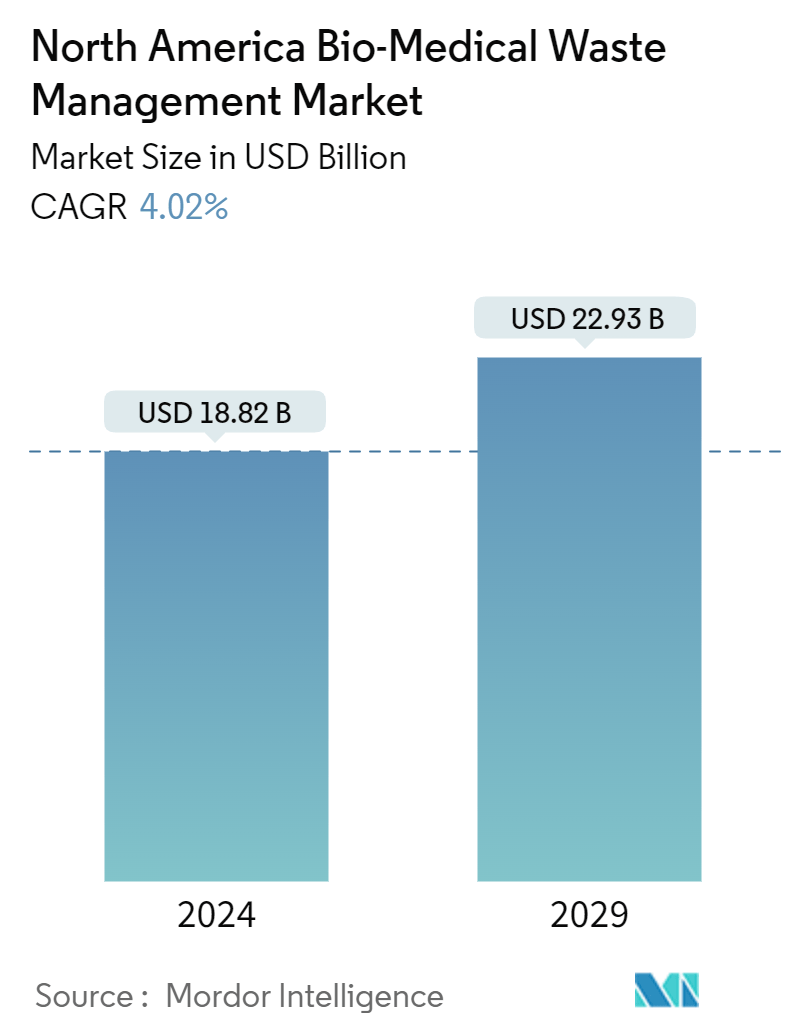
| Study Period | 2020 - 2029 |
| Base Year For Estimation | 2023 |
| Market Size (2024) | USD 18.82 Billion |
| Market Size (2029) | USD 22.93 Billion |
| CAGR (2024 - 2029) | 4.02 % |
| Market Concentration | Medium |
Major Players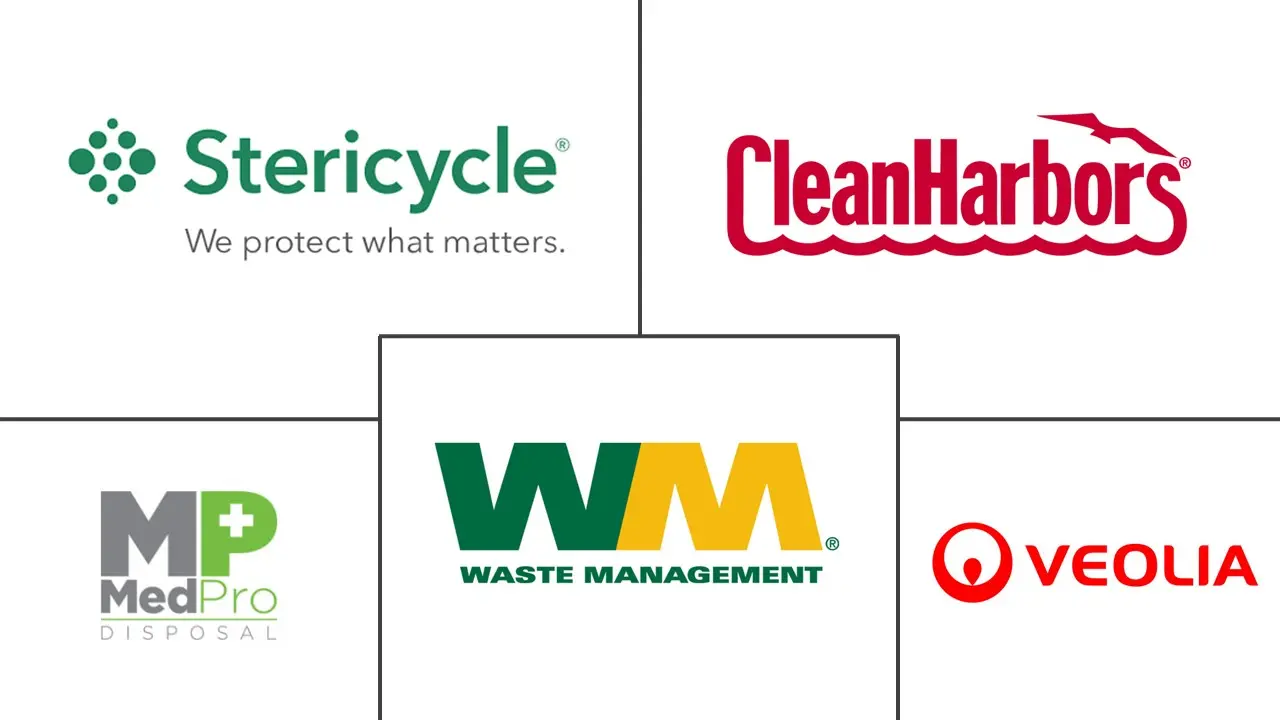
*Disclaimer: Major Players sorted in no particular order |
North America Bio-Medical Waste Management Market Analysis
The North America Bio-Medical Waste Management Market size is estimated at USD 18.82 billion in 2024, and is expected to reach USD 22.93 billion by 2029, growing at a CAGR of 4.02% during the forecast period (2024-2029).
The healthcare sector, amid its remarkable advancements, faces a pressing issue of a deluge of medical waste. Whether in bustling urban hospitals or remote clinics, institutions worldwide are struggling to navigate the complexities of handling this mounting tide of potentially hazardous materials. Effective management of medical waste is crucial to ensure the safety of healthcare workers, patients, and the general public.
The World Health Organization reports that approximately 85% of healthcare-generated waste is non-hazardous. However, the remaining 15% is deemed hazardous, encompassing infectious, toxic, or radioactive materials. Mismanagement of this waste not only jeopardizes human health but also imperils the environment. Proper segregation, treatment, and disposal methods are essential to mitigate these risks.
For instance, needle-stick injuries are notorious for transmitting grave illnesses like HIV and hepatitis. In the United States, these injuries afflict over 800,000 healthcare workers annually. Alarmingly, many of these incidents are preventable with proper disposal. Implementing stringent protocols and providing adequate training for healthcare personnel can significantly reduce the incidence of such injuries.
While the immediate health risks are evident, the environmental repercussions are equally dire. Inadequate disposal of pharmaceuticals can taint water sources, and infectious waste can fuel disease transmission. The impact is amplified in developing nations, where waste management infrastructure often lags. Investing in robust waste management systems and promoting awareness about the importance of proper disposal practices are critical steps toward addressing this global issue.
Florida boasts around 50,000 facilities that contribute to the biomedical waste stream, spanning hospitals, clinics, nursing homes, labs, funeral homes, dental and veterinary practices, pharmacies, and even body piercing and tattoo establishments.
Hospitals in the United States produce 29 pounds of medical waste per staffed bed daily on average, encompassing landfill, regulated medical, pharmaceutical, hazardous, and recyclable waste. A report in the Canadian Medical Association Journal revealed that 110 hospitals in Canada collectively generated 87,000 tons of waste annually, each with its unique disposal requirements based on risk levels.
Therefore, the management of medical waste is a critical issue that demands attention from healthcare providers and environmental agencies alike. Effective waste management practices are essential to mitigate the risks associated with hazardous waste and to protect public health and the environment. As the healthcare sector continues to grow, the importance of sustainable and efficient waste management solutions will only increase.
North America Bio-Medical Waste Management Market Trends
Hazardous Waste Management Dominating the Market
The American Hospital Association reports that hospitals in the United States collectively operate around 919,649 staffed beds. These hospitals produce over 13,000 tons of waste daily, equating to more than 4 million tons annually.
Compounding the issue, many hospital products, from wooden tongue depressors to pharmaceuticals, carry expiration dates. These items, including boxes of unused medical gloves or cotton swabs, are discarded when the expiry date surpasses.
Moreover, this disposal practice extends to instruments like the harmonic scalpel, used for surgery, and small medical-grade scissors.
In 2021, large-quantity generators in the United States produced about 35.8 million tons of hazardous waste, with 28.2 million tons being wastewater. Notably, since 2001, the nation has reduced its hazardous waste output by roughly 4.7 million tons.
In conclusion, the significant waste generated by US hospitals, coupled with the disposal of expired medical products and instruments, highlights the critical need for improved waste management practices. Reducing waste and enhancing recycling efforts are expected to mitigate the environmental impact and promote sustainability in the healthcare sector.
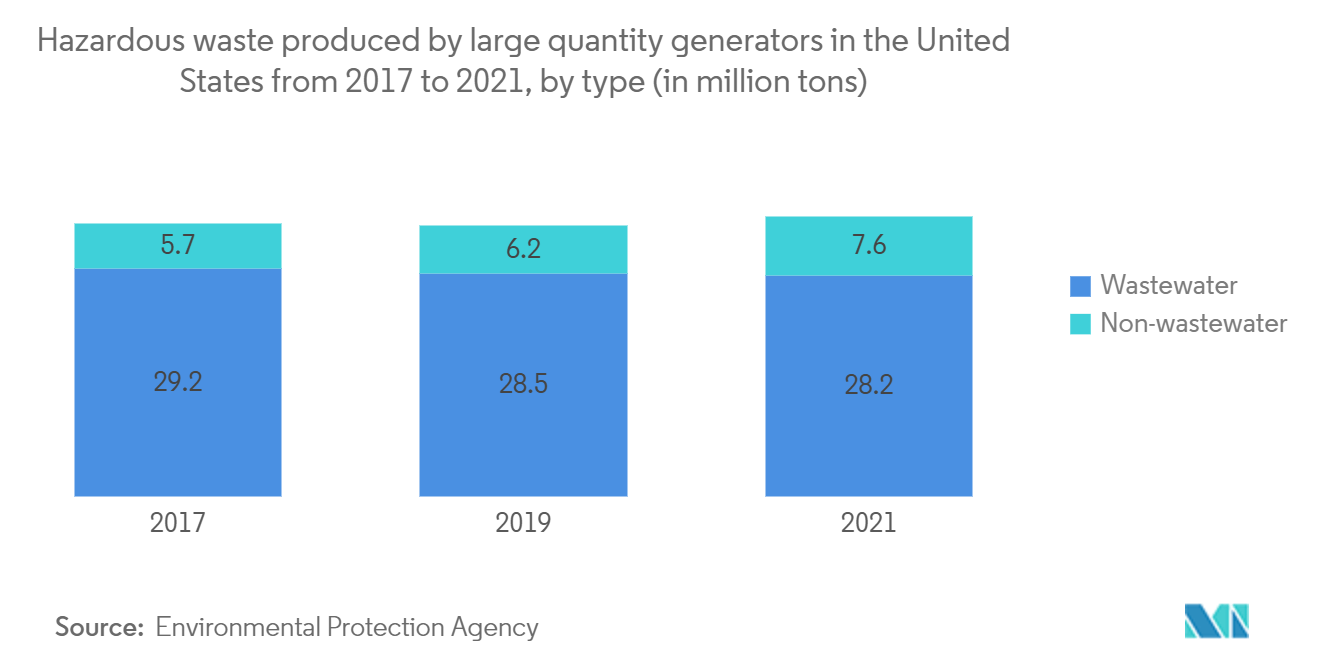
United States Dominates the Market
The United States generates an estimated 3.5 million tons of medical waste annually. This waste, while integral to the healthcare sector, poses operational challenges and financial burdens due to a lack of industry advancements. Properly managing healthcare medical waste is not only a compliance necessity but also a means to save time, money, and resources.
Given the extensive healthcare landscape in the country, which includes numerous hospitals, clinics, research centers, and pharmaceutical entities, the United States grapples with a substantial medical waste burden. This, coupled with the country's high medical activity levels, underscores the critical need for efficient waste management solutions.
As a global hub for medical R&D, the United States is experiencing a notable surge in biomedical waste generation. Ongoing innovations in medical treatments further compound the demand for specialized waste management.
The robust healthcare infrastructure in the country operates under stringent waste management regulations, necessitating advanced waste-handling processes. This regulatory environment is a key driver propelling the growth of the biomedical waste management market.
In conclusion, the significant volume of medical waste generated in the United States highlights the urgent need for innovative and efficient waste management solutions. By addressing these challenges, healthcare organizations can ensure compliance, optimize resources, and contribute to a more sustainable environment.
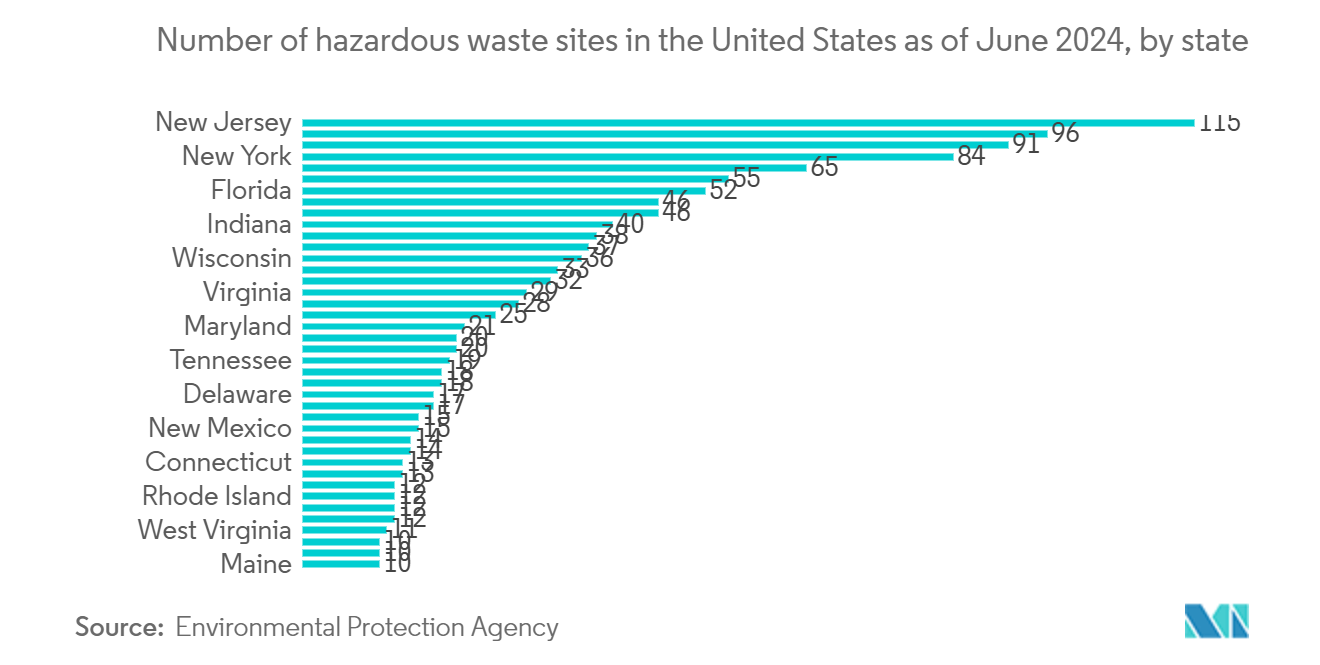
North America Bio-Medical Waste Management Industry Overview
In North America, the bio-medical waste management market is characterized by significant concentration, primarily led by a handful of key players. This dominance is a result of formidable entry barriers, substantial demands for infrastructural and technological investments, and the trend of larger entities absorbing smaller competitors.
Notable players in this landscape encompass Stericycle Inc., Veolia Environmental Services, Waste Management Inc., Clean Harbors Inc., and MedPro Disposal. Consequently, the market's competitive landscape is expected to remain stable, with these major players continuing to influence market dynamics and drive innovation.
North America Bio-Medical Waste Management Market Leaders
-
Stericycle, Inc.
-
Veolia Environmental Services
-
Waste Management, Inc.
-
Clean Harbors, Inc.
-
MedPro Disposal
*Disclaimer: Major Players sorted in no particular order
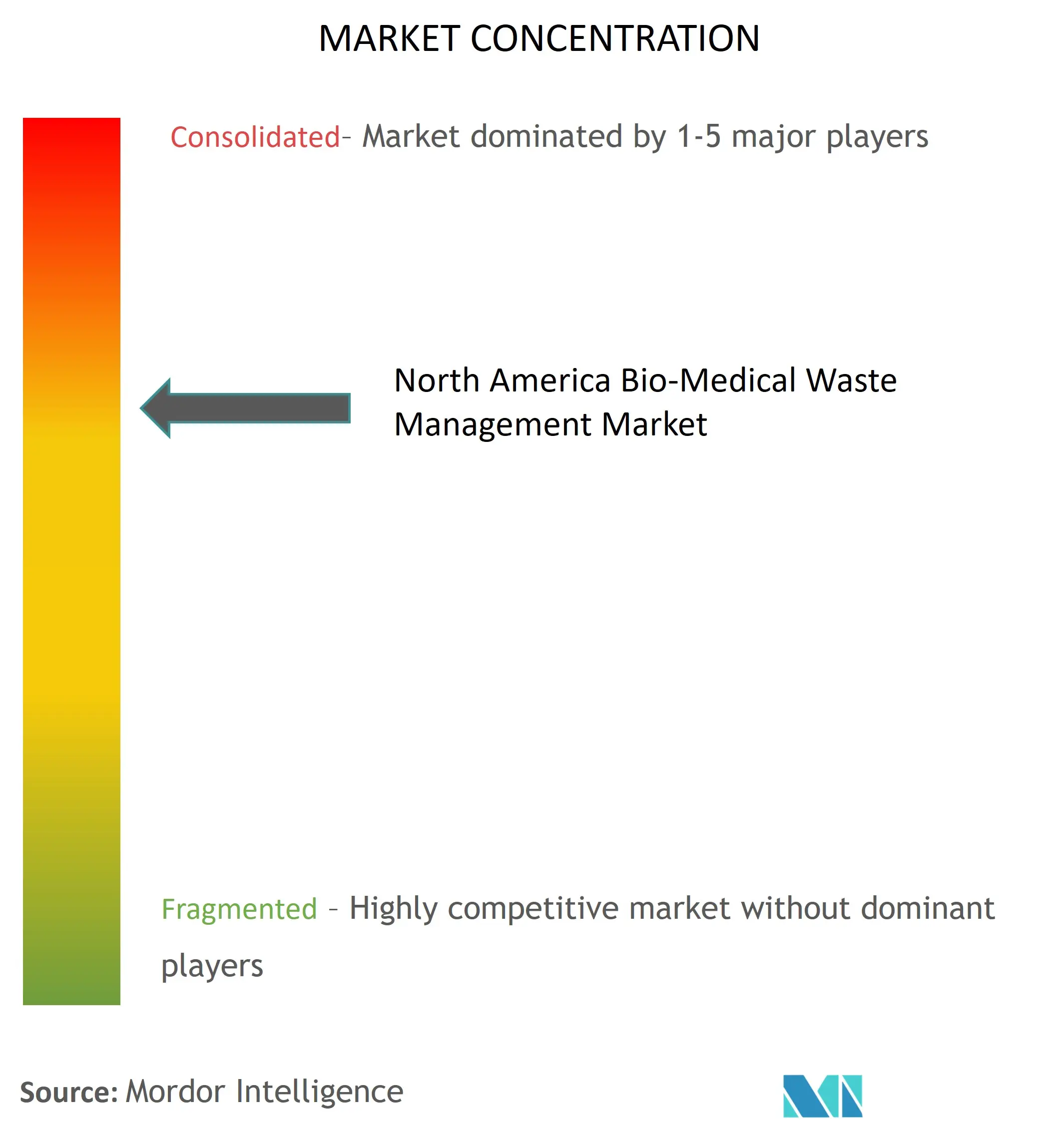
North America Bio-Medical Waste Management Market News
- June 2024: Waste Management Inc. and Stericycle entered into a definitive agreement under which WM will acquire all outstanding shares of Stericycle, representing a total enterprise value of approximately USD 7.2 billion, including approximately USD 1.4 billion of Stericycle’s net debt.
- November 2023: Veolia North America acquired US Industrial Technologies (USIT), expanding its hazardous waste market share in the United States. The acquisition of USIT also fortifies Veolia's commitment to environmental progress, focusing on fighting water and ground pollution and protecting resources through the innovative management of hazardous waste. The combination bolsters Veolia's customized services for large manufacturers in technology, healthcare and pharmaceutical as well as petro and agriculture chemical industries.
North America Bio-Medical Waste Management Market Report - Table of Contents
1. INTRODUCTION
1.1 Study Deliverables
1.2 Study Assumptions
1.3 Scope of the Study
2. RESEARCH METHODOLOGY
3. EXECUTIVE SUMMARY
4. MARKET DYNAMICS
4.1 Market Overview
4.2 Market Drivers
4.2.1 Advanced Healthcare Infrastructure
4.2.2 Increasing Research and Development
4.3 Market Restraints
4.3.1 High Capital Investment
4.3.2 Lack of Awareness
4.4 Market Opportunities
4.4.1 Technological Innovations
4.5 Value Chain/Supply Chain Analysis
4.6 Porter's Five Forces Analysis
4.6.1 Threat of New Entrants
4.6.2 Bargaining Power of Buyers/Consumers
4.6.3 Bargaining Power of Suppliers
4.6.4 Threat of Substitute Products
4.6.5 Intensity of Competitive Rivalry
4.7 Impact of COVID-19 on the Market
5. MARKET SEGMENTATION
5.1 By Type Waste
5.1.1 Hazardous
5.1.2 Non-hazardous Waste
5.2 By Service Type
5.2.1 Collection
5.2.2 Transportation and Storage
5.2.3 Treatment and Disposal
5.2.4 Other Services
5.3 By Country
5.3.1 United States
5.3.2 Canada
5.3.3 Mexico
6. COMPETITIVE LANDSCAPE
6.1 Market Concentration
6.2 Company Profiles
6.2.1 Stericycle Inc.
6.2.2 Veolia Environmental Services
6.2.3 Waste Management Inc.
6.2.4 Clean Harbors Inc.
6.2.5 MedPro Disposal
6.2.6 Republic Services Inc.
6.2.7 US Ecology Inc.
6.2.8 Sharps Compliance
6.2.9 Medasend Biomedical Inc.
6.2.10 MedPro Disposal*
- *List Not Exhaustive
6.3 Other Companies
7. MARKET OPPORTUNITIES AND FUTURE TRENDS
8. APPENDIX
North America Bio-Medical Waste Management Industry Segmentation
The biomedical waste management process encompasses several stages, such as waste collection, segregation, transportation, storage, treatment, and disposal. This comprehensive process includes transporting the waste to the final disposal site and ensuring its ultimate disposal. A complete background analysis of the North American bio-medical waste management market, including the assessment of the economy and contribution of sectors in the economy, market overview, market size estimation for key segments, emerging trends in the market segments, market dynamics, and geographical trends, and COVID-19 impact, is covered in the report.
The bio-medical waste management market in North America is segmented by type of waste (hazardous and non-hazardous waste), service type (collection, transportation and storage, treatment and disposal, and other services), and country (United States, Canada, and Mexico). The report offers market size and forecasts in value (USD) for all the above segments.
| By Type Waste | |
| Hazardous | |
| Non-hazardous Waste |
| By Service Type | |
| Collection | |
| Transportation and Storage | |
| Treatment and Disposal | |
| Other Services |
| By Country | |
| United States | |
| Canada | |
| Mexico |
North America Bio-Medical Waste Management Market Research FAQs
How big is the North America Bio-Medical Waste Management Market?
The North America Bio-Medical Waste Management Market size is expected to reach USD 18.82 billion in 2024 and grow at a CAGR of 4.02% to reach USD 22.93 billion by 2029.
What is the current North America Bio-Medical Waste Management Market size?
In 2024, the North America Bio-Medical Waste Management Market size is expected to reach USD 18.82 billion.
Who are the key players in North America Bio-Medical Waste Management Market?
Stericycle, Inc., Veolia Environmental Services, Waste Management, Inc., Clean Harbors, Inc. and MedPro Disposal are the major companies operating in the North America Bio-Medical Waste Management Market.
What years does this North America Bio-Medical Waste Management Market cover, and what was the market size in 2023?
In 2023, the North America Bio-Medical Waste Management Market size was estimated at USD 18.06 billion. The report covers the North America Bio-Medical Waste Management Market historical market size for years: 2020, 2021, 2022 and 2023. The report also forecasts the North America Bio-Medical Waste Management Market size for years: 2024, 2025, 2026, 2027, 2028 and 2029.
North America Bio-Medical Waste Management Industry Report
Statistics for the 2024 North America Bio-Medical Waste Management market share, size and revenue growth rate, created by Mordor Intelligence™ Industry Reports. North America Bio-Medical Waste Management analysis includes a market forecast outlook for 2024 to 2029 and historical overview. Get a sample of this industry analysis as a free report PDF download.



